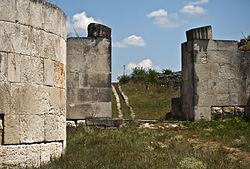Adamclisi
| Adamclisi | |
|---|---|
| Commune | |

Civitas Tropaensium Roman castra
|
|
 Location of Adamclisi |
|
| Coordinates: 44°4′45″N 27°57′15″E / 44.07917°N 27.95417°ECoordinates: 44°4′45″N 27°57′15″E / 44.07917°N 27.95417°E | |
| Country |
|
| County | Constanța County |
| Status | Commune |
| Component villages | Adamclisi, Abrud, Haţeg, Urluia, Zorile |
| Government | |
| • Mayor | Dorina Cicilia Șerbănescu (National Liberal Party) |
| Area | |
| • Total | 135.73 km2 (52.41 sq mi) |
| Population (2011) | |
| • Total |
|
| Time zone | EET (UTC+2) |
| • Summer (DST) | EEST (UTC+3) |
| Website | http://www.primaria-adamclisi.go.ro/ |
Adamclisi (Romanian pronunciation: [adamkliˈsi]) is a commune in Constanța County, in the Dobrogea region of Romania.
In ancient times, a Roman castrum named Civitas Tropaensium was settled here and in 109 AD a monument named Tropaeum Traiani was built to commemorate the Roman Empire's victories over the Dacians.
Colonized with Roman veterans of the Dacian Wars, the city was the largest Roman city of Scythia Minor and became a municipium in the year 170. Destroyed by the Goths, it was rebuilt during the rule of Constantine the Great with better defensive walls, which defended the city successfully until the Avars sacked it in 587. After that moment, it ceased to be among the important cities of Dobrogea and was no longer mentioned for seven hundred years.
During the Ottoman rule, the village was re-founded by Turkish settlers. After Dobruja was awarded to Romania, in 1878, the Muslim population left for Turkey, leaving the village deserted. However, in 1880 – 1881, the village was re-settled with Romanians from Transylvania and Teleorman.
The current name has a Turkish origin and it is an adaptation in Romanian of "Adam Kilisse" which means "the church of man" (when the Turkish people settled in this area, they thought the Ancient Roman monument was a church).
Villages in the Adamclisi commune:
...
Wikipedia
